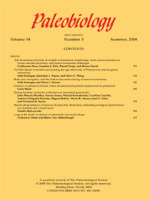The evolutionary history of a clade has traditionally been studied through phylogenetics, and taxonomic diversity has been used as a crude proxy for morphological diversity. However, morphological diversification—beyond counting taxa—can provide a very different view of a clade's evolutionary history and allows the investigation of patterns and timing of morphological evolution.
In this paper I use dentition to document the pattern of morphological and taxonomic diversification of Carnivoramorpha and mammalian meat eaters in North America. Using the dentition permits ecological inferences to be made, because teeth and diet are closely related. I present a method developed to describe the entire dentition of the Carnivoramorpha and other mammalian meat eaters (Creodonta). Morphological diversification is measured by dental disparity, using the mean pairwise dissimilarity among species.
I test the following hypotheses: (1) Morphological diversification was suppressed relative to taxonomic diversification, early in the evolutionary history of Carnivoramorpha; and (2) once an efficient system for consuming meat evolved, the dental system remained relatively unchanged.
The first hypothesis is rejected. Taxonomic and morphological diversity increase together through the clade's early evolution. There is no evidence of a morphological release in the carnivoramorphans with the demise of creodonts. The second hypothesis is supported. The ecological group “mammalian meat eaters” rapidly diversified morphologically and reached its maximum disparity early in its history, after which the dental system remained relatively unchanged.





